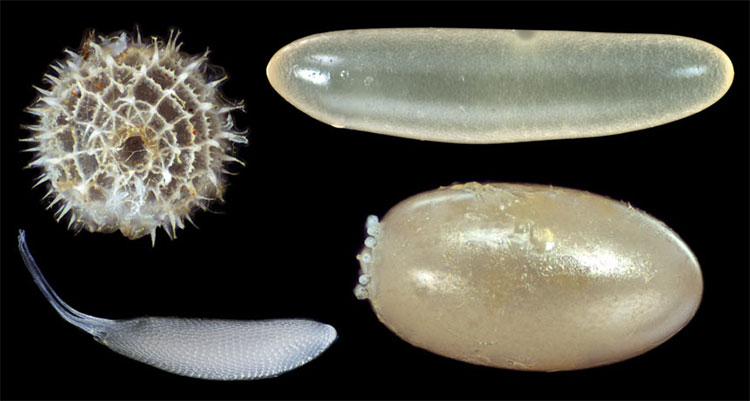Huge data warehouse contributes to explain the strange shapes of insect eggs
Some insects produce sausage-shaped eggs, ellipses or even flat shapes.

Clockwise: hairstreak butterfly eggs (Jamelnus evagoras), eggs of two-spotted mottled crickets (Gryllus bimaculatus), Earworm eggs (Oncopeltus fasciatus) and Hawaiian fly eggs (Drosophila mimica).Photo: SH Church and S. Donoughe.
Looking down at your fingernails, you can imagine the world's largest insect egg size of the Bolboleaus hiaticollis Cave Beetle . The smallest eggs belong to Platygaster vernalis , only half the width of the thinnest hair ever recorded.
Insect egg size is divided into 8 levels and has great beautiful shapes, according to a new data warehouse containing nearly 10,500 description of eggs of about 6,700 insect species. Harvard University's team - the author of this set of data - thinks they have found the cause of that transformation. In an independent analysis, the researchers determined that the location of insect-spawning insects - for example, in water or in other organisms' bodies - helps explain part of biodiversity over time. The above database and research are published July 3 in the journal 'Scientific and natural data' (Scientific Data and Nature).
'Eggs provide a great window to observe the evolution and ecological impact of animal reproduction ,' said Mary Stoddard, an evolutionary biologist at Princeton University. colleagues analyzed more than 47,000 eggs of 1,400 birds in a 2017 study, in which they found a link between bird's egg shape and its ability to fly. "The eggs are much more wild ," she said. "Some insect eggs are spherical or elliptical, but others look like arrowheads or elongated like sausages."
In order to analyze the insect egg database, the team developed a program to extract egg size from text and images in 1,756 digitized publications, thereby collecting the size and shape of eggs. belongs to 500 different families of insects.
Cassandra Extavour, an evolutionary biologist at Harvard University, says eggs are merely single cells without complex traits that disrupt comparisons, so they are a great starting point for research. how insects grow. Analysis of egg data shows amazing biodiversity. However, in particular, many groups of insects have converged designs similar to spherical or elongated, according to Samuel Church, an evolutionary biologist at Harvard University.

The average size of the Peach Cave beetle - the last right - is about 800 million times the smallest egg - the last left - belongs to the wasps.An analysis of thousands of insect eggs shows that larger eggs tend to be buried underground or hidden under dry leaves in the forest, while smaller fruits are laid in water or in other animal bodies. .(Photo: SH Church Et Al / Biorxiv.org)
Scientists have previously proposed the hypothesis of these similarities: large eggs have elongated shapes because they help children to give birth more easily . But using arisen analysis and statistics, Church and his colleagues found no basis to protect that view. Even the seemingly simple hypothesis that more eggs are related to adult body size has proved to be inadequate for many insects, the team said.
Instead, the best explanation for the shape of an egg is where it was born, according to research reports. Specifically, the eggs laid in or on the water will be small and round, while the eggs laid inside another animal tend to be smaller and more asymmetrical, with one head slightly above the head. that. Insect eggs laid in the ground or under dry leaves will be larger in size. Egg size also has no correlation with the growth rate and for many insects, there is no relationship between egg size and adult body size.
- Huge data warehouse of Facebook
- Explain why some seabirds have pear shapes
- Explore the world of exotic eggs
- Data warehouse about the world's largest galaxy
- Tiny, oddly shaped but this chicken egg can sell for 15 million VND
- Stunned with chicken eggs '2 in 1'
- Video: See the egg in the egg
- Close up of shark eggs: look like tadpoles that have 'peach hearts' like strange eggs
- Strange fasting fish to hatch eggs in the mouth
- Should eggs be eaten every day?
- What to do when data leaked?
- Finding a way to turn eggs boiled into eggs is easy
 Why do potatoes have eyes?
Why do potatoes have eyes? 'Tragedy' the world's largest carnivorous life: Death becomes ... public toilet
'Tragedy' the world's largest carnivorous life: Death becomes ... public toilet Tomatoes were once considered 'poisonous' for 200 years
Tomatoes were once considered 'poisonous' for 200 years Detecting microscopic parasites on human face
Detecting microscopic parasites on human face